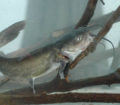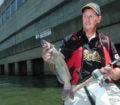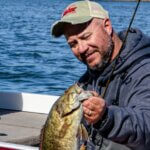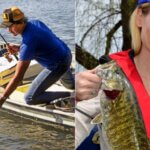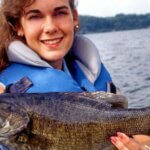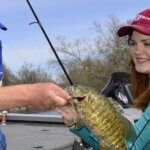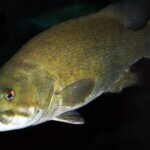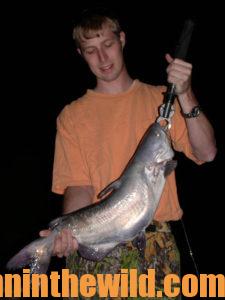 Editor’s Note: Bubbling and swirling, the swift waters of tailraces make anglers think of catfish, feeding in the current’s boils and foam in the highly-oxygenated water. But sometimes those catfish are hard to catch. Several friends of mine have solved the riddle of taking tailrace cats, after perfecting their catfish strategies on the Tennessee River that runs through Tennessee and Alabama. For more than 20 years, they have spent several days a week in the tailrace area watching anglers catch catfish as well as taking catfish themselves. Their tactics will work in tailraces throughout the nation. The key to catching catfish in tailraces is being able to read the water and knowing just where the catfish are. Although catfish roam most tailraces areas below dams because of the abundant baitfish in the water and the highly-oxygenated flow coming through the turbines, some parts of a tailrace will produce more catfish than others. However, productive spots may switch abruptly.
Editor’s Note: Bubbling and swirling, the swift waters of tailraces make anglers think of catfish, feeding in the current’s boils and foam in the highly-oxygenated water. But sometimes those catfish are hard to catch. Several friends of mine have solved the riddle of taking tailrace cats, after perfecting their catfish strategies on the Tennessee River that runs through Tennessee and Alabama. For more than 20 years, they have spent several days a week in the tailrace area watching anglers catch catfish as well as taking catfish themselves. Their tactics will work in tailraces throughout the nation. The key to catching catfish in tailraces is being able to read the water and knowing just where the catfish are. Although catfish roam most tailraces areas below dams because of the abundant baitfish in the water and the highly-oxygenated flow coming through the turbines, some parts of a tailrace will produce more catfish than others. However, productive spots may switch abruptly.
One of the easiest, most-productive methods of catching cats in a tailrace, in states where it’s allowed, is to jug fish for them. (Be sure to check your local and state restrictions.) In a tailrace, usually at some time 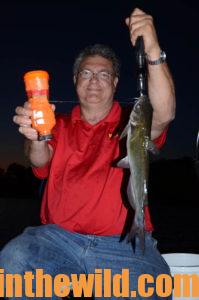 from late spring through October, jug fishing will be productive: Most jug fisherman will put out 25 to 50 jugs in the calm water to the side and below the spillways. If a number of turbines are running, and there’s no wind, the current will pull the jugs from that calm water over toward the swift water. The current may be very slight, but it still will cause the jugs to move. Cats often will concentrate and feed in that slack water and light current.
from late spring through October, jug fishing will be productive: Most jug fisherman will put out 25 to 50 jugs in the calm water to the side and below the spillways. If a number of turbines are running, and there’s no wind, the current will pull the jugs from that calm water over toward the swift water. The current may be very slight, but it still will cause the jugs to move. Cats often will concentrate and feed in that slack water and light current.
Another place that produces numbers of catfish in tailraces below dams with locks is the lock impoundment – where the discharge water is released. In high-traffic situations where discharge water is forced out of the impoundment regularly, currents that draw shad are created. With the shad come catfish. When traffic on the river is heavy, jug fishing

DCIM100GOPROGOPR2686.
around this discharge water current can be extremely productive. No matter which side of the discharge that you put your jugs on, cats will come from all directions into this part of the tailrace. Your catch may average 3 to about 20 pounds per jug.
Most anglers use pint or quart jugs with 6 feet of line tied to the jug’s neck, a piece of shot lead, either a No. 1/0 or a No. 1 hook and bait with live shad minnows if they can get them. The yellow cat seems to like the live shad minnow better than any bait, and channels and blues also will take the live shad minnow. Hook the minnow from the bottom lip to keep it alive, and allow it to swim. Shad guts and chicken guts also are used for baiting jugs and will produce catfish.
The difference between those who land cats on jugs and those who don’t land them often is the finesse used when leading a catfish to the boat. Most jug fishermen use either 30-pound-test monofilament or No. 9 trotline staging. However, line that strong makes tearing the hook out of the catfish’s mouth or straightening the hook easy. The best way to land a cat is to pick up the jug and hold it in your hand 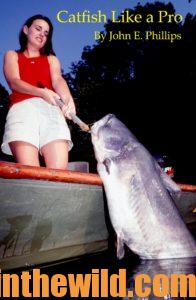 (palm up). Don’t wrestle the cat into the boat. Gently lead the fish to the surface, get your net under it, and put the fish in the boat. If the catfish
(palm up). Don’t wrestle the cat into the boat. Gently lead the fish to the surface, get your net under it, and put the fish in the boat. If the catfish 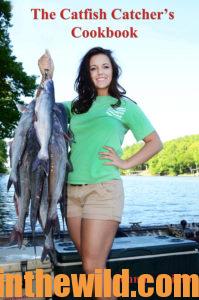 sees the boat and starts to run, drop the jug, and let the fish take it under. You can try to land the fish again when the jug comes back up. You will land more cats using less pressure than you will if you attempt to horse them into the boat.
sees the boat and starts to run, drop the jug, and let the fish take it under. You can try to land the fish again when the jug comes back up. You will land more cats using less pressure than you will if you attempt to horse them into the boat.
To learn more about catching catfish, check out John E. Phillips’ book, “Catfish Like a Pro,” available in Kindle and paperback, at http://amzn.to/W900eu. You can also get a free eBook copy of “The Catfish Catcher’s Cookbook” at https://johninthewild.com/free-books.
Tomorrow: Drift Fishing and Slow Trolling For Catfish Below Dams

